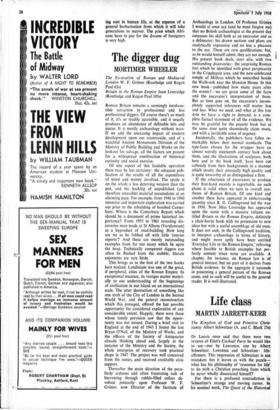The digger dug
MORTIMER WHEELER
Britain in the Roman Empire Joan Liversidge (Routledge and Kegan Paul I05s) Roman Britain remains a seemingly inexhaus- tible attraction to professional and less professional diggers. Of course there's so much of it, it's so readily accessible, and it usually produces an abundance of definable bits and pieces. It is mostly archaeology without tears. If we add the unceasing impact of modern development upon our countryside, and of a watchful Ancient Monuments Division of the Ministry of Public Building and Works on the lookout for salvage, all the factors are present for a widespread combination of historical curiosity and social exercise.
Of one aspect of this laudable operation there may be less certainty: the adequate pub- lication of the results of all the expenditure of mind and money involved. The spade is on the whole a less deterring weapon than the pen, and the backlog of unpublished (and therefore unusable) material accumulates at an alarming pace. For example, from 1946 to 1960 intensive and important exploration was carried out prior to the rebuilding of bombed Canter- bury. Where is the Canterbury Report which should be a document of prime historical im- portance? From 1955 to 1961 revealing dis- coveries were made at St Albans (Verulamium) as a byproduct of road-building. How long are we to be fobbed off with little 'interim reports'? And these are merely outstanding examples from far too many which lie upon the heap. Technically competent diggers can often be flushed from the stubble; literate exponents are rare birds.
This brings us to the first of the two books here noticed. Londinium was one of the great, if peripheral, cities of the Roman Empire. In exceptional measure, its vestiges matter materi- ally to our understanding of the beginnings of civilisation in our island on an international scale. The utter destruction of something like one sixth of the City of London in the Second World War, and the general reconstruction which this presaged, offered the last possible opportunity for considered exploration of any considerable extent. Happily, there were those whose timely prevision saw that the oppor- tunity was not missed. During a brief visit to England at the end of 1943 I found the late Bryan O'Neil, of the Ministry of Works, and the officers of the Society of Antiquaries already thinking ahead and, largely at the instance of the Ministry and the Society, the whole enterprise of recovery took practical shape in 1947. The project was well conceived from the outset, and received creditable civic support.
Thereafter the main direction of the pecu- liarly arduous and often frustrating task of burrowing through rubble-filled cellars de- volved primarily upon Professor W. F. Grimes, now Director of the Institute of
Archaeology in London. Of Professor Grimes I would at once say (and he must forgive me) that no British archaeologist at the present day surpasses his skill both as an excavator and as a delineator; his drawn sections and plans are analytically expressive and no less a pleasure to the eye. These are rare qualifications; but, as he would himself admit, they are not enough. His present book deals, inter alia, with two outstanding discoveries: the surprising Roman fort which he identified with great perspicacity in the Cripplegate area, and the now-celebrated temple of Mithras which he unearthed beside the Walbrook near the Mansion House. In this new book—published how many years after the events?—we are given some of the facts and the excavator's interpretation of them. But as time goes on, the excavator's incom- pletely supported inferences will matter less and less. What we need, and what at this late date we have a right to demand, is a com- plete factual statement of all the evidence. We may be grateful for the present book but at the same time quite shamelessly claim more, and with a justifiable sense of urgency.
Incidentally, the publishers have fallen re- markably below their normal standards. The type-faces chosen for the wrapper have an almost weirdly nineteenth century look about them, and the illustrations of sculpture, both here and in the book itself, have been cut callously from their backgrounds in a manner which insults their unusually high quality and is quite unworthy of so distinguished a firm.
If the reluctance of excavators to produce their first-hand records is regrettable, no such plaint is valid when we turn to overall syn- theses of Roman Britain. Of one kind and another these have appeared in embarrassing quantity since R. G. Collingwood led the way. in 1936. Now Miss Liversidge has appeared upon the scene with a massive volume en- titled Britain in the Roman Empire, definitely a chair-borne book with no pretension to new ideas but with a useful assemblage of old ones. It does not seek, in the Collingwood tradition, to interpret archaeology in terms of history, and might more aptly have been entitled. `Everyday Life in the Roman Empire,' referring where feasible to British examples but per- fectly content when none are available. A chapter, for instance, on Roman law is of general interest, but no part of it derives from British evidence. In the aggregate it succeeds in presenting a general picture of the Roman scene, and as such will be useful to the general reader. It is well illustrated.










































 Previous page
Previous page